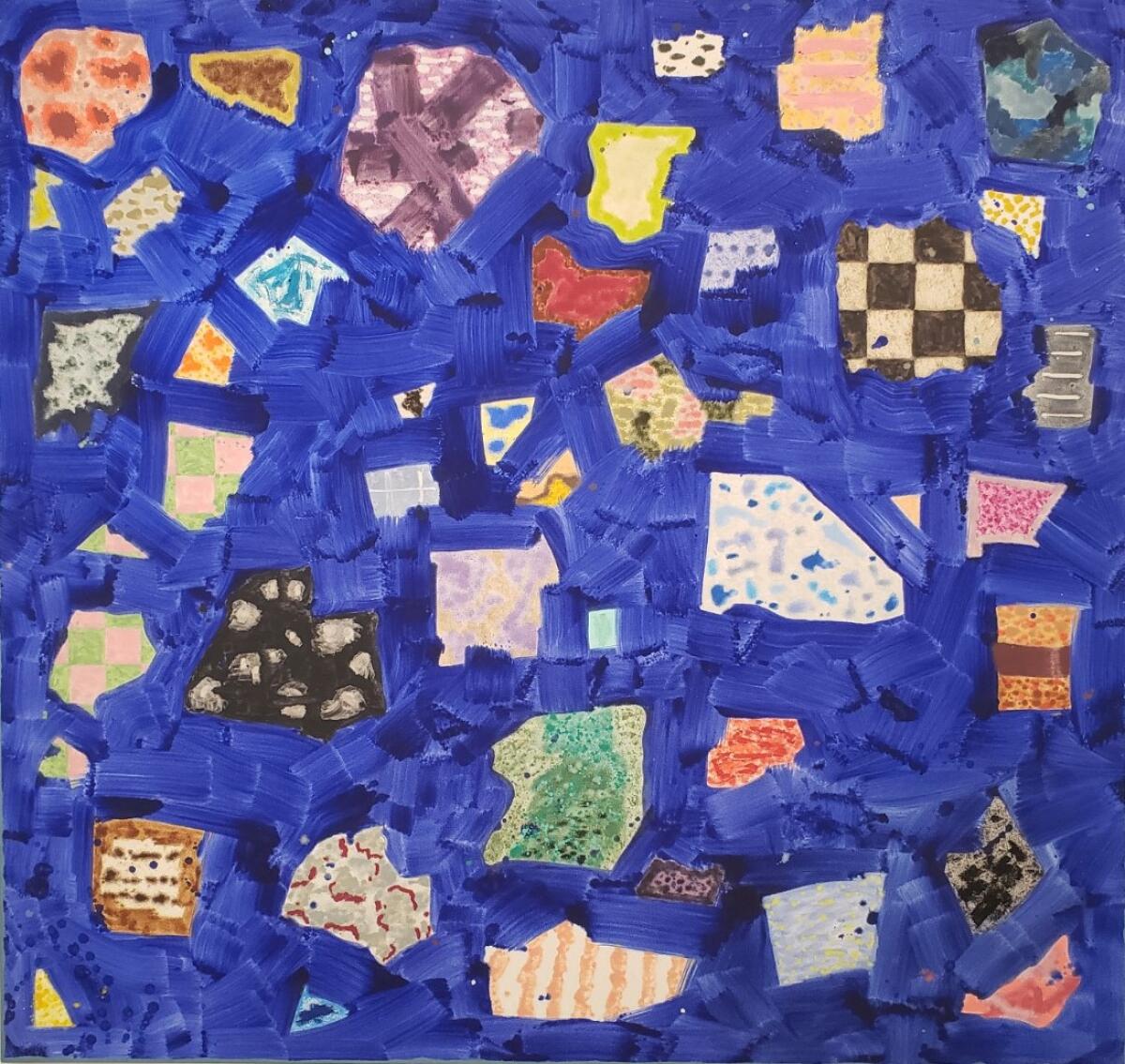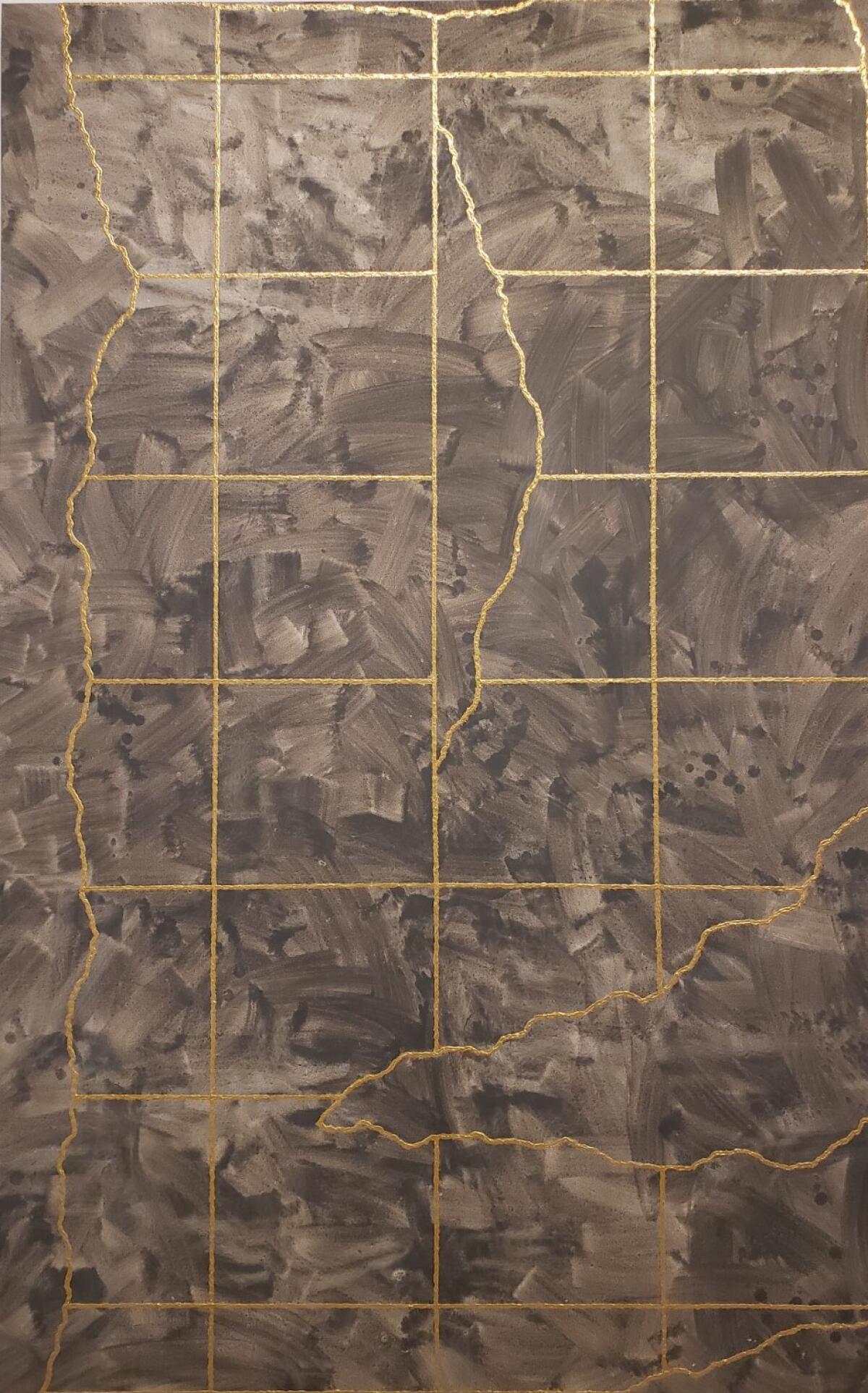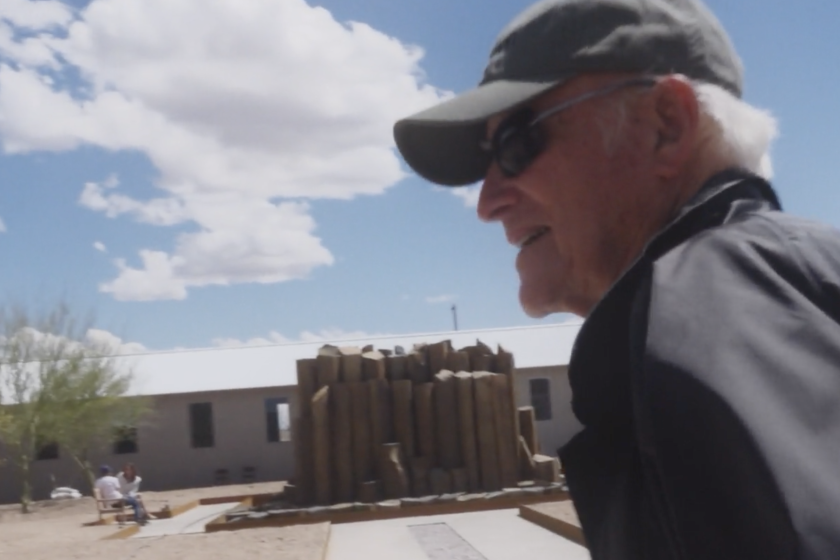The peculiar appeal of Rebecca Morris’ paintings, on view in L.A.

- Share via
In the 1990s, Rebecca Morris began to search for methods of constructing abstract paintings in surprising ways. And constructing is the operative term — as are synonyms like building, fabricating and erecting. Her paintings immediately put a viewer in the position of pondering how the composition was made.
Usually, from Piet Mondrian in the 1920s to Minimalism in the 1960s, the idea of constructing an abstraction has required building the painted picture with linear geometry. Basic colors and pure geometric forms proposed that the scaffolding for existence is an “absolute reality.” “Rebecca Morris: 2001-2022,” a tightly organized survey of 27 paintings from the last 21 years at the Institute of Contemporary Art, Los Angeles, pulls the rug out from all that.
Forget absolutism. The flat plane of the canvas and its horizontal and vertical edges are just about the only strict geometric elements that turn up in her work, and they’ve pretty much been standard going on hundreds of years in the long tradition of Western painting. The plane and the framing edges inform what she’s up to, which is partly a determination to dismantle their authority.

When Morris paints a grid as the armature of a composition, she’ll often use a hand-held spray nozzle or maybe a squeeze tube, rather than a straight-edge and a tidy brush. She doesn’t keep it neat. The pictorial grid wobbles. The horizontal and vertical movements of her arm are registered, together with a fluid sense of hand-eye coordination.
Geometry gives way to gesture.
But it’s not an emotive gesture, the way most expressionist abstraction is. She’s not asserting that her emotional inner life is manifest by an outer mark of oil paint on canvas. Instead, making marks is building the picture.
And her color is all over the place, not least in silvery or golden metallic hues that reflect light with more than usual intensity. Pure it is not.
The Honolulu-born, Los Angeles-based painter, 53, has been described as making paintings that exude a casual demeanor, which certainly fits. But that doesn’t mean they’re haphazard or disorganized. An untitled work from 2020, more than 7 feet on a side, at first reads as a collage-like arrangement of small painted images casually strewn across a vivid field of cobalt blue. Then, it begins to unfold with accelerating complexity.
The blue is not a unified field, but a dense network of short, firm, interlocking paint strokes applied with a wide brush. The collage-like elements are not painted on top of the blue color, which instead surrounds the shapes. It’s as if the small images are underpainting that peeks through the cobalt surface.
A useful but unsatisfying new documentary tackles the career of Light & Space artist Robert Irwin
‘Robert Irwin: A Desert of Pure Feeling,’ a new documentary premiering at DOC NYC, chronicles the long, often unlikely career of the 94-year-old artist.
That underpainting, rather than continuous from edge to edge across the surface, is a concatenation of independent patches, all different. A speckled black-and-white checkerboard near the upper right is nothing like a scrap of squiggly reddish stripes at the bottom, which is wholly unlike the cell-like splotches of pink and gray at the upper left. (The splotches are stained colors; Morris often paints with the canvas laid flat rather than upright.) The roughly 50 disparate patches are like separate stars inextricably connected in the unified galaxy that is the painting, all happily coexisting side by side.
Shall we call them united states?
One of the more peculiar features of Morris’ art is that her compositions feel subtractive rather than additive. Sure, she laid down those 50 small patches of abstraction on the canvas first, a checkerboard here and stripes there, then added the cobalt blue strokes around them, as if to hold everything in place to make one big abstract painting. But you come to understand how the picture was built by working backward from what you see, visually and conceptually taking it apart. You unbuild what she’s built. A taut but playful equilibrium between seeing and knowing exerts itself.
The system is encountered again in a later painting that, rather than cobalt blue, features a thick, almost viscous silver paint that puddles around the smaller patches. The silver’s liquid, light reflective quality complicates the see-through illusion.
Later still, a nearly 10-foot-tall canvas in a thin cloud of brushy gray color is overlaid with a golden metallic grid. The grid is not continuous, but is instead fractured in several places, as if pieces have been torn out. Flashes of reflected golden light animate the static intersections of horizontal and vertical lines, further destabilizing the structure, while adding subtle wit: Lightning bolts charge the underlying storm cloud of gray paint.

Less successful are several works that feature an eccentric shape — a jagged curve, which the artist refers to as a lobster claw. Perhaps the shape derives from the sweeping movement of the painter’s arm that follows naturally from working on a big horizontal canvas. (Two of them are the largest paintings in the show.) But the jumpy visual motion feels contrived, more dissonant than mysterious.
The exhibition is ably organized by former ICA LA curator Jamillah James, now at the Museum of Contemporary Art Chicago, where it travels next year, and curatorial assistant Caroline Liou. It’s divided into sections based on shared formal strategies among various works, rather than chronology. (A catalog is expected in 2023.) The gallery’s wall configuration, which has been fixed for quite some time, has now been opened up in refreshingly spacious ways that allow a viewer to visually cross-reference paintings.
The formal emphasis is fitting. In a period when figurative painting with distinct social narratives has been dominant, while facile abstract painting abounds, a fine survey of Morris’ savvy, often unexpected abstractions is especially disarming.
Rebecca Morris
Where: ICA LA, 1717 E. 7th St.
When: Wednesdays-Sundays, through Jan. 15; check for holiday closures
Admission: Free
Info: (213) 928-0833, www.theicala.org
More to Read
The biggest entertainment stories
Get our big stories about Hollywood, film, television, music, arts, culture and more right in your inbox as soon as they publish.
You may occasionally receive promotional content from the Los Angeles Times.












